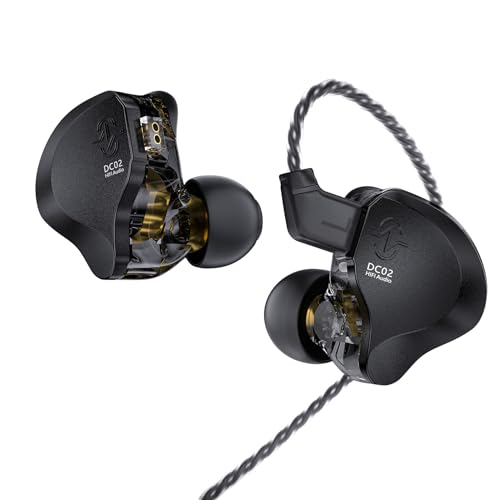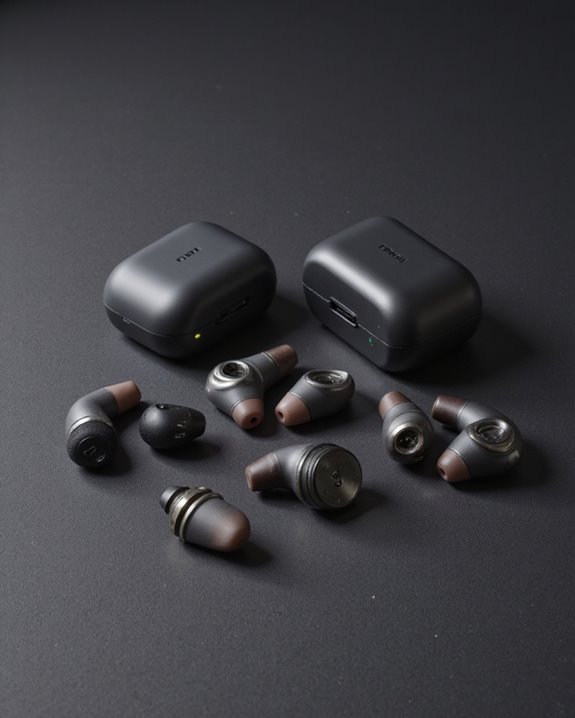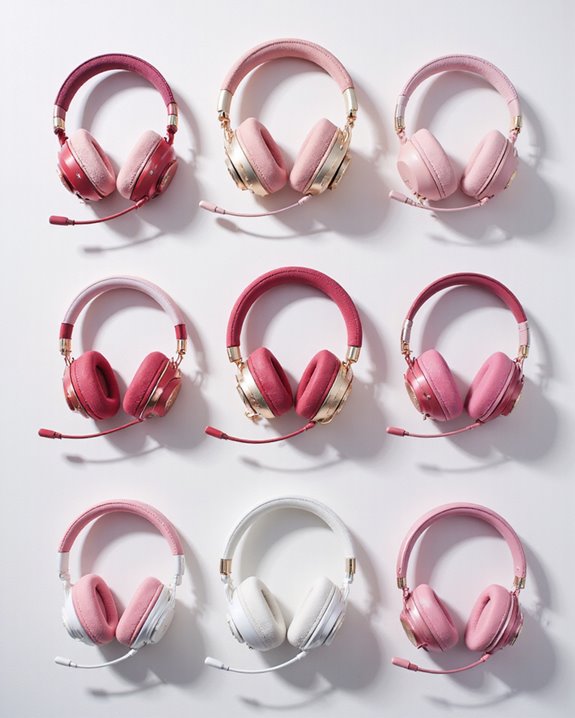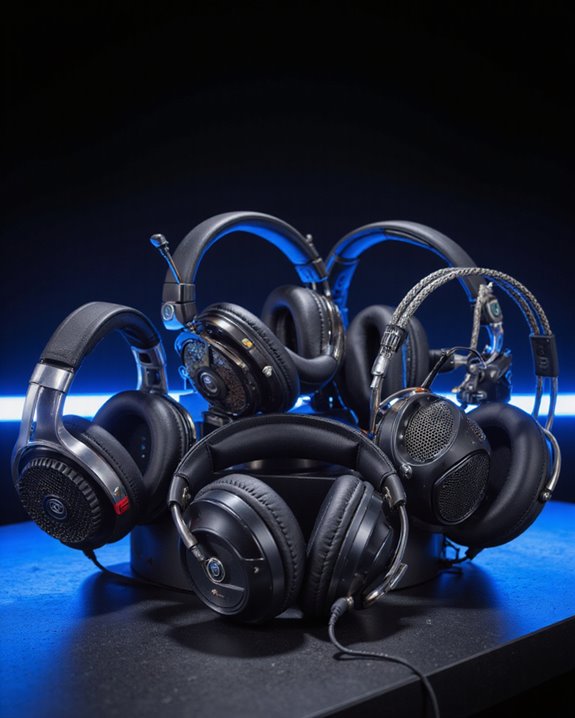Links below are affiliate links. We earn a commission on purchases at no extra cost to you. Although our opinions are based on curated research, we haven't used these products. Articles generated with AI.

The 3 Best In-Ear Monitors of 2025, According to Sound Engineers
Sound engineers have identified the CCZ DC02, Xvive U4, and CCA CRA as 2025’s top in-ear monitors. The CCZ DC02 features a dual magnetic circuit with a PU+PET composite diaphragm for balanced monitoring, while the Xvive U4 delivers uncompressed 2.4GHz wireless audio with under 5ms latency. The CCA CRA stands out with its dual magnetic driver and 3.8μ ultra-thin diaphragm. Let’s explore how each model’s unique specifications can enhance your monitoring experience.
Key Takeaways
- CCZ DC02 excels with its dual magnetic circuit and PU+PET composite diaphragm, delivering professional-grade audio monitoring capabilities.
- CCA CRA offers exceptional value with its dual magnetic driver and ultra-thin diaphragm, producing clear sound separation across frequencies.
- Xvive U4’s uncompressed wireless transmission and ultra-low latency make it ideal for live performance monitoring.
- Premium build quality sets CCZ DC02 apart with zinc alloy construction, while maintaining lightweight comfort at 2.08 ounces.
- CCA CRA’s wide frequency response (20Hz-40kHz) and high sensitivity (105 dB) ensure superior sound reproduction across all ranges.
CCZ DC02 IEM Dual Magnetic Circuit In-Ear Headphones
in Ear Monitor Headphones,CCZ DC02 In Ear Monitor Dual Magnetic Circuit DD Wired Earbuds...
- Dual Magnetic Circuit 10MM DD in Ear Monitor Headphones,Clear Earbuds Headphones CCZ DC02 in ear monitor headphones adopts dual magnetic circuit 10mm DD,Making the sound...
- Full Metal Cover in ear headphones wired ccz dc02 in ear monitor headphones for musicians adopts zinc alloy material,which make the professional in ear monitor headphones...
- Professional tuning in ear monitor headphones The unit enable ccz dc02 Wired Earphones to possess a transparent and natural sound in overall, elastic lows, sufficient...
The CCZ DC02 IEM delivers professional-grade audio monitoring through its dual magnetic circuit design, making it an ideal choice for musicians, sound engineers, and audiophiles who need precise sound reproduction.
You’ll experience balanced audio through the 10MM dynamic driver with PU+PET composite diaphragm, delivering transparent natural sound with elastic lows and mellow vocals. The extensive sound field and excellent separation guarantee you won’t miss any details during critical listening or performance monitoring.
The robust zinc alloy construction weighs just 2.08 ounces, while the ergonomic design with patented earfins and eartips provides fatigue-free extended wear. The detachable 4N OFC cable with 3.5mm jack ensures stable transmission across all your professional audio equipment.
Best For: Professional musicians, audio engineers, and serious audiophiles seeking high-quality in-ear monitors with precise sound reproduction and comfortable long-term wear.
Pros:
- Premium build quality with zinc alloy construction and ergonomic design
- Excellent sound separation and balanced audio profile with detailed mids and controlled highs
- Professional-grade detachable cable with high-quality 4N OFC construction
Cons:
- Not water resistant, limiting outdoor use scenarios
- Premium pricing compared to consumer-grade earphones
- Limited touch controls may not suit users wanting extensive on-device control options
Xvive U4 Wireless In-Ear Monitor System
Sale
Xvive U4 Wireless in-Ear Monitor System Professional IEM System Transmitter and Beltpack Receiver...
- Great 2.4GHz Band: 2.4GHz wireless in-ear monitor system create your personal or team's monitor system; uncompressed wireless signal transmission, low noise and...
- Efficient Power Circuit and Listening Effect: Rechargeable Lithium Battery,5 hours of battery life,comes with power cable,ensures great performance for your every...
- Less than 5ms Latency: Simultaneous broadcasts on 6 channels no-interference, Less than 5ms Latency,Up to 107 dB signal-to-noise ratio provides clear, detailed audio at...
Professional musicians and audio engineers will appreciate Xvive’s U4 Wireless In-Ear Monitor System, featuring uncompressed 2.4GHz wireless transmission with remarkably low latency under 5ms. The system delivers pristine audio quality with a 107 dB signal-to-noise ratio and 24-bit/48kbps resolution across a full 20Hz-20KHz frequency range.
You’ll get up to 5 hours of performance from the rechargeable lithium battery, while the built-in limiter prevents distortion at high input levels. The U4 system supports simultaneous broadcasting of 6 channels without interference, and you’ll find both XLR and TS input options for flexible connectivity. The rugged metal construction guarantees reliability during intense stage performances.
Best For: Professional musicians, live performers, and audio engineers seeking a reliable wireless in-ear monitoring system with low latency and high-quality audio transmission.
Pros:
- Extremely low latency (under 5ms) with uncompressed audio transmission
- Supports simultaneous broadcasting of 6 channels without interference
- Built-in limiter prevents distortion and robust metal construction ensures durability
Cons:
- Relatively short battery life at only 5 hours
- Limited to mono input options (XLR and TS)
- Higher price point compared to wired monitoring solutions
CCA CRA In-Ear Monitor Headphones with Detachable Cable
CCA CRA in Ear Monitor Headphones, Ultra-Thin Diaphragm Dynamic Driver IEM Earphones, Clear Sound &...
- 【SUPERIOR SOUND QUALITY】- CCA CRA in ear monitor headphones feature upgraded dual magnetic driver, It makes low frequency to be more extraordinary, with better...
- 【ULTRA-THIN DIAPHRAGM】- Diaphragm thickness: 3.8μ, ultra-thin diaphragm born to be outstanding sound quality. It exceeds the liquid crystal polymer film and carbon...
- 【LIGHT & COMFORTABLE WEAR EXPERRIENCE】- Ergonomic cavity structure, lightweight cavity with auricle PU memory hook, effectively reduces the pressure on the ear, even...
Audiophiles seeking exceptional value will find the CCA CRA In-Ear Monitors punching well above their $18-$24 price point. These IEMs feature a dual magnetic driver system with a 3.8μ ultra-thin diaphragm, delivering clear sound separation and deep bass across a wide 20Hz-40kHz frequency range.
The metal and resin construction weighs just 22 grams, while the detachable 130cm OFC cable provides durability. You’ll appreciate the ergonomic design with PU memory hooks that reduce ear pressure during extended listening sessions.
With 105 dB sensitivity and compatibility via 3.5mm jack, these monitors excel in music playback, gaming, and performance monitoring. While not professional-grade IEMs, they outperform similarly priced competitors like the KZ EDX and ZSN Pro.
Best For: Budget-conscious music enthusiasts, casual gamers, and content creators seeking high-quality sound performance in an affordable in-ear monitor.
Pros:
- Exceptional sound quality with clear separation and deep bass for the price range
- Comfortable, lightweight design with detachable cable and ergonomic fit
- Durable metal-resin construction with water resistance and included carrying case
Cons:
- Not suitable for professional audio monitoring or studio work
- Some users report minor issues with the included microphone
- Limited advanced features compared to higher-end IEMs
Factors to Consider When Choosing In-Ear Monitors
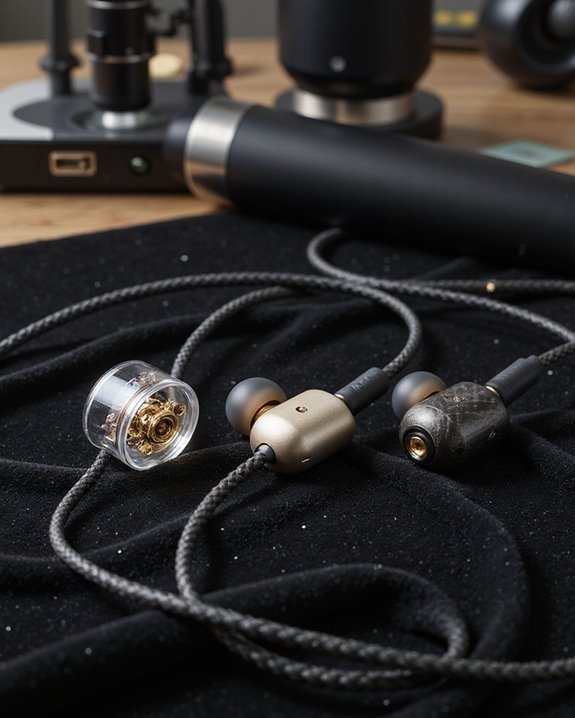
When you’re ready to select your ideal in-ear monitors, you’ll need to evaluate several key factors that directly impact your listening experience. The most critical considerations include sound quality across all frequency ranges, wearing comfort with proper seal and fit, and your choice between wired or wireless connectivity options that match your usage needs. Your decision should also account for the monitor’s construction quality, including the durability of housing materials and cable design features like detachability and strain relief.
Sound Quality and Range
The sound quality and range of in-ear monitors serve as critical factors that’ll determine your overall listening experience. You’ll want to look for models offering a wide frequency response between 20 Hz and 20 kHz to guarantee you’re hearing everything from deep bass to crisp highs.
Pay attention to sensitivity levels of 103 dB or higher, which provide powerful output without requiring much amplification. A signal-to-noise ratio and dynamic range of around 107 dB will give you clearer sound with minimal interference and better handling of volume variations.
For professional applications, you’ll need monitors with latency under 5 milliseconds to prevent audio delays. These technical specifications work together to deliver accurate, detailed sound reproduction that’ll meet both studio and live performance demands.
Fit and Wearing Comfort
Beyond superior sound quality, proper fit and wearing comfort make the difference between in-ear monitors you’ll love using and ones that’ll collect dust.
When evaluating fit, you’ll want to focus on three key elements: ergonomic design, weight, and materials. Look for monitors featuring curved shapes or over-ear hooks that keep them securely in place during movement. The best models weigh under 2 ounces to prevent fatigue during long sessions.
Pay attention to the ear tips – they’re essential for comfort. Silicone or memory foam options create a cushioned seal that reduces pressure points. Features like earfins and angled nozzles help align naturally with your ear canal’s shape.
A properly fitted monitor shouldn’t cause discomfort even after hours of use. You shouldn’t need to adjust them frequently or experience irritation around your ear canal.
Wired Vs Wireless Options
Deciding between wired and wireless in-ear monitors represents one of the most essential choices you’ll face when selecting your monitoring solution. Each option offers distinct advantages that can greatly impact your performance experience.
Wired monitors provide uninterrupted, battery-free operation through their physical connection, making them ideal for extended sessions where reliability is essential. You won’t need to worry about charging or power management during lengthy performances.
Wireless systems offer impressive technical specifications, including ultra-low latency under 5ms and signal-to-noise ratios up to 107 dB. With the ability to support up to 6 simultaneous channels, they’re excellent for group performances where multiple musicians need independent monitoring.
Consider your specific needs: If you require absolute reliability and unlimited runtime, go wired. If you need mobility and don’t mind managing 5-hour battery life, wireless systems offer comparable audio quality with freedom of movement.
Build Material Durability
Material durability stands as a critical factor when you’re investing in professional in-ear monitors, with construction quality directly impacting both longevity and performance.
Metal components offer exceptional durability against daily wear, while water-resistant designs protect your investment from moisture damage during intense performances. You’ll want to look for models featuring lightweight construction, ideally around 2 ounces, to prevent strain during extended use.
A key feature to evaluate is detachable cables, which allow you to replace worn connections without purchasing an entirely new unit. Modern manufacturing techniques incorporating specialized resins and metals create monitors that maintain their structural integrity even after years of professional use. These materials guarantee your in-ear monitors can withstand the rigors of regular stage performances and studio sessions while delivering consistent audio quality.
Cable Design Features
The cable design of your in-ear monitors greatly influences both performance reliability and user experience. When evaluating cables, you’ll want to focus on three key aspects: material quality, durability, and comfort features.
High-purity materials like oxygen-free copper deliver superior signal stability and cleaner audio transmission. You’ll find that detachable cables are particularly valuable, as they’re easily replaceable and allow you to customize your setup based on specific needs.
Standard lengths of 120-130cm provide ideal versatility for most users, while tangle-free braided designs make daily handling hassle-free. Look for ergonomic features such as memory wire hooks near the ear pieces – they’ll guarantee your monitors stay securely in place during extended sessions.
For maximum longevity, choose cables with reinforced connection points and strain relief systems that prevent wear from regular movement.
Noise Isolation Capability
Mastering noise isolation stands as a critical factor when selecting in-ear monitors, as it directly impacts your listening experience and audio clarity. The effectiveness of your monitors’ noise isolation depends primarily on the physical seal created between the ear tips and your ear canal.
You’ll find that ear tips come in various materials, with silicone and foam being the most common options. Foam tips typically offer superior isolation by conforming to your ear canal’s shape, while silicone tips provide a balance of comfort and sound blocking.
The monitor’s ergonomic design and insertion depth also play vital roles. You’ll want to make sure your chosen model allows for deep, secure placement, as this greatly enhances noise isolation. Remember, better isolation means you won’t need to increase volume to overcome ambient noise, protecting your hearing while maintaining audio quality.
Price to Performance Ratio
Striking the right balance between cost and quality becomes essential when investing in in-ear monitors, as you’ll want to maximize value without overspending on unnecessary features. Look for models that deliver high-quality specifications like wide frequency responses and robust sensitivity levels without inflating the price tag.
When evaluating options, compare the dynamic range and signal-to-noise ratio against the cost to guarantee you’re getting meaningful performance improvements for your money. Consider durability factors too – monitors made with quality materials that maintain performance over time often provide better long-term value.
Don’t forget to check customer satisfaction metrics and ratings, as they’ll help you gauge real-world performance relative to cost. For wireless models, prioritize battery life, while wired options should emphasize build quality and sound accuracy at their price point.
Connectivity and Compatibility
Selecting in-ear monitors with ideal connectivity and compatibility guarantees you’ll get seamless integration across your audio ecosystem. When evaluating options, you’ll need to evaluate both wired and wireless capabilities to match your setup requirements.
For wired solutions, look for monitors that support both balanced and unbalanced connections through standard audio jacks. This flexibility guarantees you can connect to various audio interfaces and personal devices without additional adapters.
If you’re considering wireless models, focus on those operating in the 2.4GHz frequency band with latency under 5ms. You’ll want reliable signal transmission without noticeable delays, especially for live performances.
Multi-channel support is vital if you’re working in group settings. Make sure your chosen monitors can handle simultaneous connections when needed for band performances or studio sessions.
Frequently Asked Questions
How Long Do In-Ear Monitor Batteries Typically Last Before Needing Replacement?
Like a marathon runner’s endurance, your in-ear monitor’s battery life varies considerably based on usage patterns. You’ll typically get 4-8 hours from most wireless models using standard lithium-ion batteries, while higher-end units can last 8-12 hours per charge. If you’re using replaceable batteries, quality alkaline cells will give you 6-10 hours. For wired monitors that don’t require power, you won’t need to worry about battery life at all.
Can I Use In-Ear Monitors With My Hearing Aids?
Using in-ear monitors (IEMs) with hearing aids requires careful consideration. You’ll need to check if your hearing aids are compatible with IEMs and whether they can be safely removed when using monitors. Some hearing aid users opt for custom-molded IEMs that accommodate their devices, while others work with audiologists to find solutions that combine both technologies. It’s crucial to consult your hearing healthcare provider before attempting to use IEMs with your hearing aids.
What’s the Average Lifespan of Professional In-Ear Monitors With Regular Use?
With proper care and maintenance, you can expect your professional in-ear monitors (IEMs) to last 3-5 years of regular use. Your IEMs’ lifespan largely depends on usage patterns, storage habits, and cleaning routines. You’ll maximize their longevity by storing them in a protective case, cleaning them regularly, and avoiding exposure to extreme temperatures. Some high-end models can last up to 7 years, while budget options might need replacement after 2-3 years.
Are Custom-Molded In-Ear Monitors Worth the Extra Cost?
If you’re a performing musician or audio professional, custom-molded IEMs are absolutely worth the investment. You’ll get superior noise isolation (up to -26dB), perfect fit for extended wear comfort, and enhanced sound quality due to the sealed acoustic chamber. While they’re pricier ($500-1500+) than universal-fit models, custom IEMs last longer since they’re built to your exact ear shape. The improved audio accuracy and comfort make them essential for serious stage work.
How Often Should I Clean My In-Ear Monitors?
You should clean your in-ear monitors after every use to prevent wax buildup and maintain ideal sound quality. Use a soft brush to remove debris from the nozzles and wipe down the shells with an alcohol-free cleaning solution. For deep cleaning, remove the removable filters monthly and clean them with specialized tools. If you’re using custom IEMs, schedule professional cleanings every 6 months to guarantee proper maintenance and longevity.

